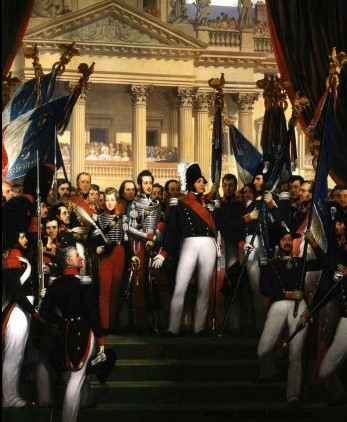 The July Monarchy is a constitutional and liberal monarchy resulting from the revolutionary days known as the Trois Glorieuses (July 27, 28 and 30, 1830) which led to the abdication of Charles X and the proclamation of Louis Philippe d'Orléans as King of the French. Favorable to the business community, this new regime is traditionally considered as that of the triumph of the bourgeoisie. Abroad, the July Monarchy seeks peace through a policy of cordial understanding with Great Britain while giving a second wind to the French colonial empire through a new policy of conquests (North Africa and Black Africa, Far East, Pacific). Having become authoritarian and reactionary, it was carried away by the revolution of February 1848.
The July Monarchy is a constitutional and liberal monarchy resulting from the revolutionary days known as the Trois Glorieuses (July 27, 28 and 30, 1830) which led to the abdication of Charles X and the proclamation of Louis Philippe d'Orléans as King of the French. Favorable to the business community, this new regime is traditionally considered as that of the triumph of the bourgeoisie. Abroad, the July Monarchy seeks peace through a policy of cordial understanding with Great Britain while giving a second wind to the French colonial empire through a new policy of conquests (North Africa and Black Africa, Far East, Pacific). Having become authoritarian and reactionary, it was carried away by the revolution of February 1848.
Louis-Philippe, the “enlightened” prince of the future July Monarchy
Louis-Philippe was born in Paris on October 6, 1753. He was descended from the Capétiens by his father, the Duke of Burgundy Philippe Égalité, and by his mother Adélaïde de Bourbon-Penthièvre, daughter of the Count of Toulouse, himself a descendant of Louis XIV. Titled Duke of Valois then Duke of Chartres in 1785, his training was provided by the Countess of Genlis, who was keen to provide him with extensive training and education, in the spirit of the Enlightenment. Also, from 1789, the young prince was won over by revolutionary enthusiasm and even joined the Club des Jacobins. He participated in the first battles of the revolutionary army but, saddened by the murderous wave of Terror, he betrayed the revolutionary ideal.
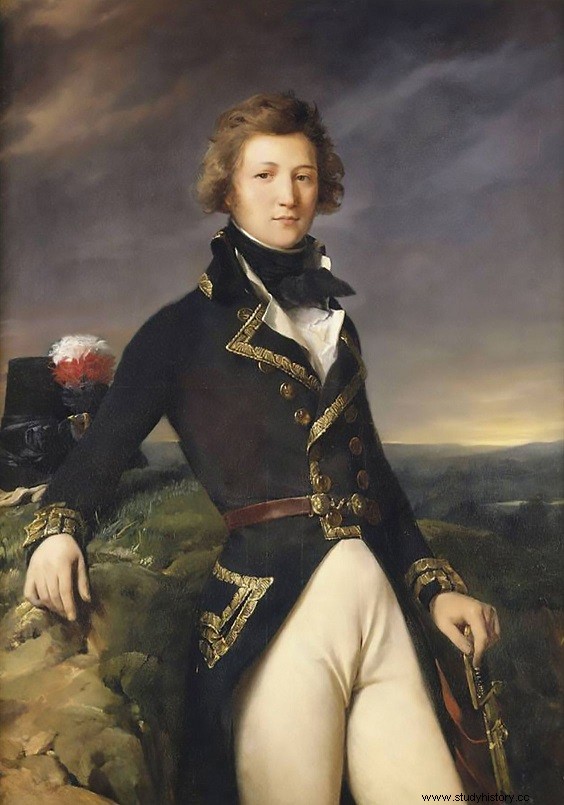 In 1793, after the execution of his father, Philippe Égalité, he took refuge in Switzerland, America, in Sweden, Germany and England. A refugee in Sicily in 1809, he married Princess Marie-Amélie de Bourbon. In 1814, his attempts at reconciliation with Louis XVIII were successful. However, it was not until 1817 that the prince, who became Duke of Orléans, came out of his long exile, which did not prevent him from fighting against his cousin's policy, thus becoming the emissary of the liberals.
In 1793, after the execution of his father, Philippe Égalité, he took refuge in Switzerland, America, in Sweden, Germany and England. A refugee in Sicily in 1809, he married Princess Marie-Amélie de Bourbon. In 1814, his attempts at reconciliation with Louis XVIII were successful. However, it was not until 1817 that the prince, who became Duke of Orléans, came out of his long exile, which did not prevent him from fighting against his cousin's policy, thus becoming the emissary of the liberals.
The difficult succession of Charles X
Following the publication of the four ordinances of Saint-Cloud and the revolt of the people of Paris during the Trois Glorieuses, King Charles X was forced to abdicate in Rambouillet . Anxious to ensure the dynastic succession from his own line, he convinced his son, the Duke of Angoulême and Dauphin of France, to refuse his accession to the throne in favor of his grandson, the Duke of Bordeaux.
The Dauphin, under the name of Louis XIX, therefore only reigns for a few minutes, and the Duke of Bordeaux, who has become the pretender to the throne Henry V and titled Count of Chambord, does not manages to impose itself only in the eyes of legitimists. The dynastic succession, as planned by King Charles X, plans to appoint the Duke of Orléans regent of the kingdom.
Louis-Philippe's accession to the throne
During the 1830 revolution, part of the bourgeoisie chose, to ensure the continuity of power, to favor Prince Louis-Philippe, also a descendant of the Capetians. The establishment of a republic is mentioned, but the memory of the Terror is such that the royalists and the liberals quickly agree to set up a liberal parliamentary monarchy. This is how many Republicans, disregarding Charles X's abdication text, offered the Duke of Orléans the lieutenancy general of the kingdom.
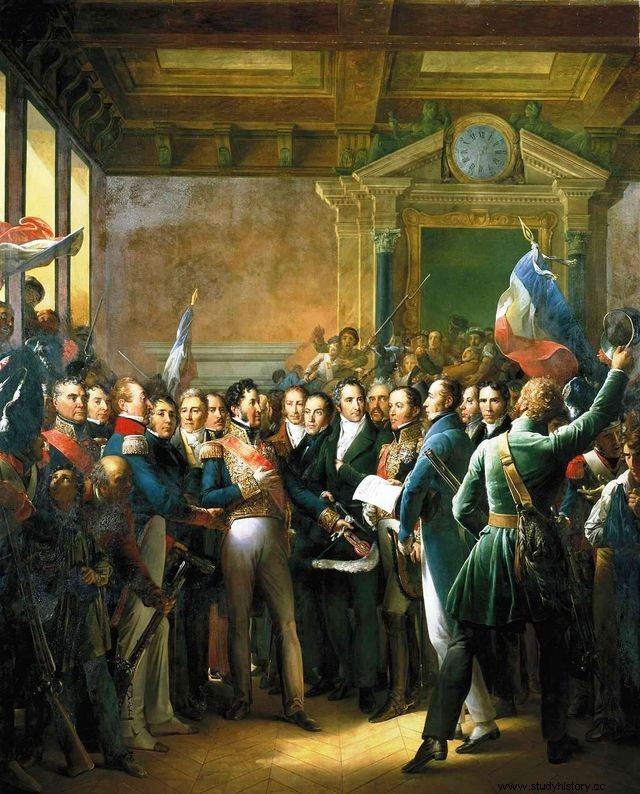 The prince, feeling the tide turning in his favor, was reluctant to accept the succession proposed by Charles X. On 31 July, Louis-Philippe was presented to the Parisians and on August 7, 1830, following the favorable vote of the deputies and peers, constituting the two parliamentary Chambers, he officially became Louis-Philippe I, King of the French. He takes an oath to the new Constitution and swears to remain faithful to the Constitutional Charter of 1814, it is true somewhat modified by Parliament.
The prince, feeling the tide turning in his favor, was reluctant to accept the succession proposed by Charles X. On 31 July, Louis-Philippe was presented to the Parisians and on August 7, 1830, following the favorable vote of the deputies and peers, constituting the two parliamentary Chambers, he officially became Louis-Philippe I, King of the French. He takes an oath to the new Constitution and swears to remain faithful to the Constitutional Charter of 1814, it is true somewhat modified by Parliament.
The Constitutional Charter of the July Monarchy
In the aftermath of the July Revolution, the governmental system of the Constitutional Charter of 1814 is extended. Louis-Philippe, counting on the ambition of politicians, uses the new tax-based electoral system to consolidate his power. France is therefore experiencing an appreciation of the representative regime, which has become parliamentary. The kingdom also benefits from the development of the economy, thanks to the repercussions of the nascent industrial revolution.
The Constitutional Charter divides Parliament into two Chambers. That of the deputies, elected for five years by the suffrage censitaire, and that of the peers, whose assembly, hereditary, is renewed by the king. But the law of December 29, 1831 suppresses the royal appointment to the peerage. The Upper House therefore no longer plays an important political role. In addition, the deputies want to modify the rules governing access to the vote, the determination of the quota and the conditions for standing for election. On April 19, 1831, a law reduced the annual property tax and lowered the minimum age required to vote.
Some liberal opponents accuse the sovereign of having applied a conservative policy, opposed to the liberal spirit and to any reform, when he did, after all, than skillfully respecting the principles and rights enshrined in the Constitutional Charter. When he inherits the throne, Louis-Philippe I wants to exercise all the fullness of royal prerogatives. To achieve its ends, it relies on the intrinsic weaknesses of the parliamentary system. On several occasions, the king uses his right to dissolve the Chamber in order to ultimately obtain a majority of deputies in favor of his policy. In addition, most of the presidents of the Council, faced with the iron will of the monarch, do not dare to put up resistance.
An ambitious foreign policy
The sovereigns of Europe accept with difficulty the establishment of the July Monarchy. Louis-Philippe succeeded, outside his borders, in maintaining peace, to the great misfortune of the French people, nostalgic for the great victorious Napoleonic campaigns. If, in 1831, the king refused the throne of Belgium in the name of his son, the Duke of Nemours, he nevertheless accepted the marriage of his daughter Louise with Léopold of Belgium in 1832.
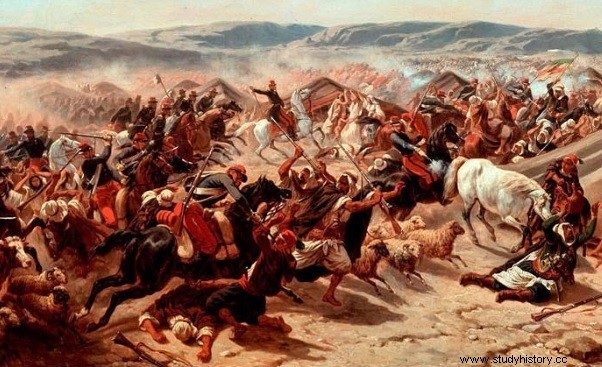 French troops are involved in the restoration of peace in Portugal, in the wars waged in Mexico and in Argentina. France occupies the Marquesas Islands and becomes involved commercially with China. The alliance with England in no way lessens the commercial and political rivalry between the kingdoms of France and Great Britain in Spain, Greece and the Ottoman Empire. A treaty of 1845 suppresses the slave trade. Meanwhile, France extends its colonial hold on Africa. The occupation of Algeria and Morocco intensified, with the surrender of the Emir Abd el-Kader to the Duke of Aumale in 1847.
French troops are involved in the restoration of peace in Portugal, in the wars waged in Mexico and in Argentina. France occupies the Marquesas Islands and becomes involved commercially with China. The alliance with England in no way lessens the commercial and political rivalry between the kingdoms of France and Great Britain in Spain, Greece and the Ottoman Empire. A treaty of 1845 suppresses the slave trade. Meanwhile, France extends its colonial hold on Africa. The occupation of Algeria and Morocco intensified, with the surrender of the Emir Abd el-Kader to the Duke of Aumale in 1847.
Teaching and the Church
The law of June 28, 1833 gives secular authorities responsibility for primary education, to the detriment of the Church. Schooling has not yet been made compulsory, but we nevertheless note that the government's provisions aim, as a whole, to allow the middle classes to have access to teaching and education. The training is very diversified, without any specialization so that the positions within the State are not reserved for a privileged class.
In 1842, the government even legislated on child labor in factories. Under the impetus of the Republicans, the July Monarchy proclaimed the secularism of the State, allowing the sovereign to free himself from the influence of the Church and to make substantial savings.
Major works policy and the world of the arts
Works of public utility are undertaken or completed, such as the Arc de Triomphe, the Eglise de la Madeleine or the Hôtel de Ville in Paris. The Palace of Versailles becomes a national museum intended to stage the major military and political events in the history of France. Napoleon's remains were even, with great pomp, deposited at the Invalides. Finally, long railway lines begin to be built to connect the major cities of France.
Under the July Monarchy, romanticism first inspired the great innovators of the world of arts and letters. Romantic art brings lithography up to date, while the world of painting is undeniably dominated by Eugène Delacroix. Jean Auguste Dominique Ingres perpetuates the tradition of historical painting and portraiture.
Government action
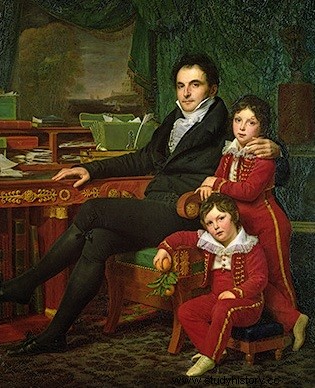 There is a great gap between Paris and the provinces, between those nostalgic for yesterday's privileges and the beneficiaries of new diets. Placed between parties with often quite extreme positions, Louis-Philippe I was forced to adopt a moderate and liberal policy, partially reconciling the Republicans, Monarchists, Legitimists and Bonapartists. According to his compromises and his political reversals, also according to the revolts fomented against him, the king will appoint, as president of the Council, the banker Jacques Laffite. Faced with Republican opposition, the king then turned around by appointing, in 1831, Casimir Perier as head of government, followed by the Duke of Dalmatia, Marshal Nicolas Soult.
There is a great gap between Paris and the provinces, between those nostalgic for yesterday's privileges and the beneficiaries of new diets. Placed between parties with often quite extreme positions, Louis-Philippe I was forced to adopt a moderate and liberal policy, partially reconciling the Republicans, Monarchists, Legitimists and Bonapartists. According to his compromises and his political reversals, also according to the revolts fomented against him, the king will appoint, as president of the Council, the banker Jacques Laffite. Faced with Republican opposition, the king then turned around by appointing, in 1831, Casimir Perier as head of government, followed by the Duke of Dalmatia, Marshal Nicolas Soult.
The government legislates on essential matters such as the freedom of the press, the reform of the Penal Code, the repression of the slave trade and the liberation of slaves, the abolition of houses gambling and lottery or recruiting for the army. But the economic crisis, weakening the kingdom from 1845, suddenly put a brake on legislative reforms and the liberalization of the country.
The agricultural crisis of 1846-1847 left rural populations and workers weakened and discontented. The opposition asserted itself more and more and the king, aging, had to face the multiplication of attacks. The Presidents of the Council follow one another more and more quickly, with, in addition to the ministry of Marshal Soult, the cabinets of the historian and journalist Adolphe Thiers, Count Louis Matthieu Molé and François Guizot.
Regime crisis and end of the July Monarchy
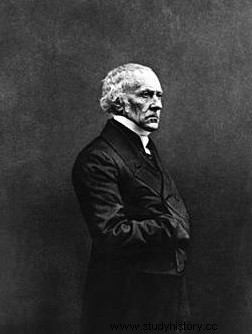 The parliamentary monarchy system, characterizing the July Monarchy, is gradually weakened by internal conflicts and instability chronicle of the French executive. The instability lies essentially in the permanence of personal quarrels, much less than the prohibition of a radical banquet, and the repression which is carried out in the capital, the government of François Guizot is forced to resign. The revolution spread throughout Paris and the king, faced with the need to calm people down, preferred to abdicate rather than fire into the assembled crowd.
The parliamentary monarchy system, characterizing the July Monarchy, is gradually weakened by internal conflicts and instability chronicle of the French executive. The instability lies essentially in the permanence of personal quarrels, much less than the prohibition of a radical banquet, and the repression which is carried out in the capital, the government of François Guizot is forced to resign. The revolution spread throughout Paris and the king, faced with the need to calm people down, preferred to abdicate rather than fire into the assembled crowd.
In his act of abdication, Louis-Philippe I instituted as dynastic heir his grandson Henri, Count of Paris, while the Duchess of Orléans became regent of the kingdom. But the Republicans, determined to seize power, set up a provisional government. Alphonse de Lamartine and Alexandre Auguste Ledru-Rollin proclaim the advent of the Second Republic.
In the face of opponents to his regime, the king decides to go into exile. He fled to England where Queen Victoria, with diplomacy, placed Claremont Castle at his disposal, where he adorned himself with the title of Count of Neuilly. On August 26, 1850, the old monarch died at the age of 77.
Bibliography
- History of the July Monarchy (1830-1848), by Sébastien Charletty. Perrin, 2018.
- The July Monarchy, by Hervé Robert. April, 2017.
- Louis-Philippe:the unknown, by André Castelot. Perrin, 1994.
